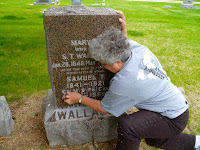We stayed an extra day on the farm in Iowa. I'd finished my family research and we had a day to spare. We felt so comfortable interacting with the host family and the workers, we weren't ready to leave. Art loves to cook for people he cares about, so he took over Stacy's kitchen and made spaghetti, Italian bread, his special salad, and biscotti for the meal to take to the workers.

Stacy and I served the dinner out of the back of her Suburban at three farm sites. We even had a teenager say he liked spaghetti - for the first time in his life! Maybe it was the sausage in the sauce rather than ground beef.

On Wednesday we started driving west. We took backroads most of the way. There was no traffic on the roads - no competion from the 18 wheelers that ply the interstate. We spent the night in Pierce, Nebraska, in a comfortable but elaborately decorated B&B two miles out of town on a dirt road.
Thursday we stopped at Ashfall State Park. I'd read about this place in a Bill Bryson book called "A Short History of Nearly Everything." About 12 million years ago there was a volcanic eruption in what is now southern Idaho, from the same hotspot that now generates the activity at Yellowstone. The ash cloud spread across the continent. At a certain point the ash fell. At that time the area that's now Nebraska was a savannah. Animals at a watering hole breathed the ash and died - first the birds and small animals, then the larger animals. They died in the watering hole, and the ash covered them before scavengers could scatter their bones.
Then, in 1971, a paleontologist was doing some surveying on a farm, and he found, at the edge of a small ravine, the intact skull of a baby rhinoceros. He came back with a crew to explore further, and they found dozens of intact (articulated) skeletons. They've been digging ever since. In a covered area called the Rhino Barn, we can see the results of their dig on display. Mother rhinos lying next to babies. Completely intact birds. Fascinating!
On Friday we arrived in Gordon, Nebraska, where my great grandparents Samuel and Mary Catherine Wallace are buried. I found them in the cemetery on the hill right away. I was surprised to find myself close to tears, standing there looking at the evidence of my connection to past generations. The cemetery is irrigated, and the minerals from the hard water have tarnished the stones. I asked Art if we could try to clean up the headstone while we were in town, and he agreed.
I was in Gordon to gather more information about my mother's family. Everyone I met, I told my story. The first night, after we got back from dinner, the hotel clerk's husband gave me a name and phone number - Harlen Wheeler, the local historian, was expecting my call!
At breakfast the next morning, the restaurant owner referred me to Kim at the city office. I went there and talked to her, as well as to Frank, the city manager, and Mike, the city guy responsible for the cemetery. He drove out there with us and tried using a fine-grain sandpaper on the tombstone, which worked. Mike told us some of the history of the city and showed us the snowy owl babies in the big fir tree. Then I talked to Charlotte, who does genealogical research as her hobby and church calling.
At the cemetery I found the graves of my great uncle Edward and his wife Annie, and my great aunt Lutie and her five year old daughter Dorothy Grace, whom I'd never known about. We drove to Rushville, the county seat, and I went through my great grandfather's probate papers. There I found the married name of another great aunt, Vene, and the description of the land my great grandfather bequeathed to his six children - confirming that he'd obtained 160 acres as a homestead when he arrived in Nebraska in 1885. This morning I met Harlen, the historian and storyteller, at the local museum, and found a picture of my great grandfather, taken with a group of Civil War veterans, and one of my great aunt Vene at her 10-year high school reunion.
In all my Gordon explorations, the people of the town were friendly and eager to help me. They gave suggestions: try the city library, go over to the American Legion hall and see if there are any records, check out the rural cemetery rolls and see if any of Samuel and Mary Catherine's four other children are buried someplace else. I did all those things. Everyone I talked to was helpful and supportive. It was a wonderful example of small town hospitality.
Today we bought sandpaper at the True Value hardware store. Both of us worked on my great grandparents' tombstone and it took about two hours. Very tiring for 60-something arm muscles! But we were happy with the result, and I expect the spirits of Samuel and Mary Catherine felt the same way.

Tomorrow morning we leave for our weeklong tour in South Dakota. This has been a grand week!





















